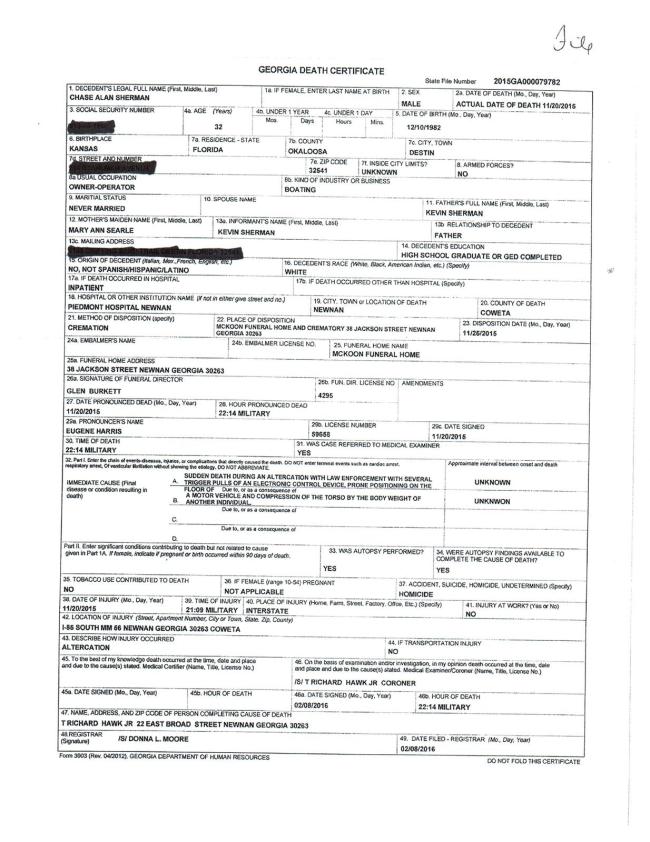The Persistence of Fatal Police Taserings

Photo Credit: Courtesy of Chase Sherman's family
Chase Sherman died after being Tasered by police in Coweta County, GA last year.
“[Taser International has] continually denied any connection between Tasers and the deaths that have followed their use. Much like the tobacco industry of yesteryear, Taser International claims that the people who died after being struck by Tasers would have died anyway; so long as there is no definitive proof that the Taser was the only cause of death in each situation, they simply will not accept that they are to blame. Meanwhile, where research does indicate that Tasers can kill, Taser International is quick to look the other way. Given how much money is on the line, such behavior—though abhorrent—is not necessarily surprising, but the fact that they have gotten away with it for so long is incredibly hard to stomach.”—Dori Thomas
“Of the hundreds who have died following police use of Tasers in the USA, dozens and possibly scores of deaths can be traced to unnecessary force being used.”—Susan Lee, Americas Program Director, Amnesty International
“I think that something is wrong in America when the police electrocute folks on a weekly basis with their Taser arsenal…and the public is mute in its response.”—Electronic Village blogger
Due in large part to the widespread use of dashcams, bodycams and cellphone cameras, the American public in recent years has become increasingly aware of the previously unappreciated fact that police commit acts of violence.
Not all police violence is condemnable, of course. From time to time, police must protect the public and themselves when dealing with violent crimes or dangerous criminals; and as long as the police violence is called for under the circumstances and is reasonable in extent, the conduct of law enforcement agents is lawful. On the other hand, unnecessary or excessive police violence is not only unlawful but, because it is a hallmark of secret police regimes, wholly unacceptable in a democracy.
The images captured by the new photographic technology make it obvious that some of the violence committed by American police, and perhaps a lot of it, is unlawful.
There is, therefore, a newfound interest in obtaining accurate information about police use of force in this country. This means, among other things, that we need reliable statistics about police violence. We cannot address the problem of unlawful police violence unless we possess adequate statistical information about all police violence, lawful as well as unlawful.
Police Violence and Official Crime Statistics
What can we learn about police violence from the official crime statistics compiled by the federal and state governments?
According to those statistics, for example, how many citizens each year do police officers kill, or shoot or shoot at, or club with batons or flashlights, or beat with fists, or subject to pepper-spraying or tear-gassing or to hog-tying or choke-holds? How many citizens are bitten by police dogs or injured as a result of high-speed police car chases? How many citizens end up with a fractured skull or jaw, a broken nose, broken bones or smashed teeth after an encounter with police? How many citizens are injured when militarized police squads, in what is now a standard practice, detonate explosive devices (charmingly misnamed “flash-bangs”) inside residences in the course of executing warrants?
And, finally, how many citizens are tasered by police?
Astonishingly, you will not find answers to these questions in official government crime statistics.
A bizarre feature of our criminal justice system is its abject failure to gather or disseminate official information on police violence, whether that violence is fatal or nonfatal, lawful or unlawful. Crime statistics compiled by the government ooze with data about acts of violence committed by citizens against other citizens or by citizens against police officers, but do not provide any significant statistical data about acts of violence committed by police against citizens.
Tasering of Citizens as Police Violence
Police tasering of citizens is a form of police violence. Tasers—manufactured and marketed by Taser International—are dangerous electroshock weapons. When deployed they administer powerful electrical shocks that incapacitate the victim by inflicting extreme pain and causing debilitating muscular disruption. Wired electrode barbs with enough force to penetrate two inches of clothing are propelled into the body of a tasered person, who is then subjected to a jolting, agonizing electrical shock. Tasered persons scream with pain, lose control of their muscles, collapse and writhe or convulse.
Study after study has shown that Taser weapons do not reduce other forms of police violence. Tasers add to the sum of police violence.
Police taserings are not only police violence, but an increasing form of police violence. Sixteen thousand law enforcement agencies—around 90% of all local, state and federal police forces—are now equipped with Tasers; the number of police agencies using Tasers continues to grow; and it is evident from news media reports that the circumstances in which police use Tasers against citizens are continually expanding.
Tasers were originally marketed on the claim that they provided police with a nonlethal alternative to firearms in the subduing of violent offenders.
These days, however, police deploy Tasers in a growing number of situations not involving violent criminals, situations neither discussed nor anticipated when Tasers were first introduced.
Police taser nonviolent persons as well as petty offenders. They taser pregnant women, the elderly, and children; they taser naked people and the mentally ill; they taser persons already handcuffed or tied down in a restraint chair or hospital bed. They taser prisoners already securely locked up in a jail cell. They taser non-suspects simply for fleeing approaching officers. They electroshock citizens with Tasers not once but multiple times. There are videos depicting Taser use by groups of policemen who have surrounded and are standing over an unarmed suspect already lying on the ground.
There is also ample evidence (including YouTube videos) that, in the words of Heather Digby Parton, Tasers “are often used when police simply lose their patience with citizens who are disrespecting their authority or are being verbally abusive…Far too often police resort to the Taser when they could use a little psychology or empathy instead.”
Moreover, police commonly use Tasers as a “pain compliance” device. They deploy or threaten to deploy a Taser to compel a citizen to obey an officer’s command, even where the citizen has not committed or threatened any violent act and even though a minor offense—e.g., failing to fasten seatbelt or walking an unleashed dog—may be involved. The sickening video of poor Sandra Bland’s traffic stop is classic; the police officer threatens to “light up” the young woman if she won’t exit her vehicle. Threatening to taser a citizen, without more, may not amount to police violence, but it is an act of threatened violence by police.
Tasers have also turned out not to be the nonlethal weapons they were initially claimed to be.
An Alarming Pattern of Fatal Police Taserings
It is evident from news media accounts, and confirmed by the private researchers mentioned below, that since the early part of this century an alarming pattern has emerged: year after year, month after month, American police kill people with Tasers. On a regular basis, citizens die suddenly, shortly, unexpectedly or suspiciously after being electroshocked one or more times by police deploying Tasers. The horrifying scenario is almost always the same. The electroshocked victim becomes unresponsive; experiences respiratory distress and gasps for air; stops breathing; turns blue; loses consciousness; suffers cardiac arrest or a heart attack and dies.
There are more and more documentaries focusing on the lethal aspects of policing with Tasers. One, Tasered: The Israel Hernandez Story, released in 2014, focuses on the tragic death of an 18-year old street graffiti artist tasered by police in Miami Beach, FL. The most recent such documentary, released last November, is director Nick Berardini’s Killing Them Safely. This “chilling documentary,” in the words of reviewer Dori Thomas, “opens with footage of Taser’s inventor repeatedly using the device to incapacitate a buffalo, and the deeply unsettling nature of this footage touches everything that follows.” The documentary “utilizes a number of archival videos in which dozens of people are tazed in a variety of situations. In the most disturbing of these videos, non-violent civilians die after being tazed by police.”
Tellingly, Taser International employees who failed to disclose their connections to the company have been caught posting unfavorable reviews of this documentary on Amazon or iTunes.
Originally, it bears repeating, Tasers were touted as nonlethal weapons. Unlike firearms, they were not, we were assured, lethal weapons. Nowadays, however, doubtless as a result of the undeniable persistence of fatal taserings by police, Taser International and the police agencies that use Tasers no longer proclaim that Tasers are nonlethal weapons. Instead they now use an invented, conveniently ambiguous term to describe Tasers. Tasers, they claim, are “less-lethal” weapons, whatever that means. Their assertion is absurd. Weapons are either lethal or nonlethal; there is no such thing as a weapon that is neither lethal nor nonlethal.
By abandoning the pretense that Tasers are nonlethal, and by now describing Tasers as less-lethal, those who defend Tasers are in effect conceding that Tasers no longer can be categorized as nonlethal weapons. Since the only other category of weapons consists of lethal ones, Tasers must be lethal weapons. So-called “less-lethal” weapons are simply a type of lethal weapon, certainly not as lethal as firearms but lethal nonetheless. This may be what Peter Bright means when he describes Tasers as “occasionally lethal” weapons.
Taser apologists may claim that “less-lethal” simply means “nonlethal,” but then unanswerable questions arise: Why the change in semantics? Why are the apologists no longer comfortable labeling Tasers as nonlethal weapons? How can they deny that less-lethal necessarily implies lethality? And—perhaps most importantly—in view of the stark fact that there have been many hundreds of fatal police taserings of citizens over the last decade and a half, how can there any longer be any quibbling, semantical or otherwise, about whether Tasers are lethal weapons?
Police Violence and Unofficial Crime Statistics
In recent years, as a result of growing public awareness of American police violence, private citizens and private organizations have begun investigating and publishing statistics about police killings of citizens.
Killed by Police, for example, a website established on May 1, 2013, endeavors to provide “the most accurate, most comprehensive and always up-to-date list of people killed by U.S. law enforcement officers.” According to the calculations of this website, at least 1,205 people were killed by U.S. police in 2015; at least 1,112 were killed in 2014; and at least 3,089 have been killed since May 1, 2013
Another website, Fatal Encounters, is endeavoring “to collect information about officer-involved homicides going back to January 1, 2000.” The website documents (as of August 2015) the killing of 10,314 people by our police since 2000. D. Brian Burghart, the journalist responsible for the website, says he has completed only about half the research work; he estimates that when the research is finished at the end of this year the number will reach 20,500.
Last year the staff of an English newspaper, The Guardian, created a website, The Counted, arguably the most reliable source of data on recent slayings by American police. The website provides a day-by-day account of the killings by police last year. According to the website, our police killed 1,140 citizens in 2015. The website provides background information on each of the killings, giving the cause of death of the named victims, setting forth the state and county or city where the slaying occurred, and summarizing the incidents in which the victims were slain. (The website also provides similar information about the 117 persons it reports have been killed by the police thus far in 2016.)
Because these and other private researchers confine their investigations of police violence to incidents resulting in a fatality, there are still no adequate statistics on the enormous amount of nonfatal police violence. Even incidents where as a result of an encounter with police the citizen is paralyzed or rendered comatose or seriously, painfully or permanently injured or disfigured, are not included in the crime statistics compiled by these independent researchers. There are, in short, still no adequate crime statistics, official or nonofficial, regarding nonfatal acts of violence (including nonlethal taserings) committed by police.
Fatal Police Taserings and Unofficial Crime Statistics
Although there are no official governmental statistics about taserings of citizens by police, and no unofficial statistics on nonfatal police taserings, there are (due to the efforts of various private researchers) trustworthy statistics on fatal police taserings.
Electronic Village, for example, lists 634 police tasering fatalities occurring between 2001 and Oct. 13, 2014, with 25 of these fatalities between Jan. 1 and Oct. 13, 2014.
Truth Not Tasers, a Canadian website, lists 916 fatal police taserings occurring in North America between Aug. 10, 1983 and Jan. 10, 2015, with 49 of them prior to 2001. (Almost all the 916 fatal tasering incidents took place in the United States; a handful were in Canada.)
Fatal Police Taserings, a website posted on Dec. 27, 2013 by Lauren Farmer and myself, is based on our own extensive research. Our website documents and summarizes the factual details surrounding 618 fatal police taserings we located that took place between Jan. 1, 2001 and Oct. 13, 2013. Our website proves that during the first 14 years (less three and a half months) of this century, the average number of citizens fatally tasered by our police was at least 44 per year, or nearly four per month. The largest number of fatal police taserings in one year was in 2006, when there were 73.
It also appears from our website that from 2003 through 2013 at least 17 Georgians were killed by police with Tasers.
The best source of statistical information on the fatal police taserings that occurred in 2015 is The Guardian’s website, The Counted. With respect to the cause of death, this website divides the 1,140 persons killed by police into five categories: (1) Gunshot (1015 fatalities); (2) Taser (50 fatalities); (3) Death in Custody (41 fatalities; these typically involve arrestees injured during the arrest or while in jail); (4) Struck by Vehicle (33 fatalities; these typically involve innocent drivers or passengers in an automobile struck by a police vehicle engaged in a high-speed car chase); and (5) Other Causes (1 fatality).
Thus, last year tasering was the number two cause of death for persons killed by police, with an average of slightly more than four persons being fatally tasered each month by police.
The Counted also reveals: Of the 50 police tasering fatalities in 2015, 15 (nearly one-third) of the victims were electroshocked multiple times: two were shocked four times, two were shocked three times, and six were shocked twice. The five other multiple electroshocking victims were, according to news accounts, shocked an unspecified number of times: one victim received “multiple electroshock weapon discharges;” another victim was “shocked with a Taser several times;” a third victim was “shocked in the chest with a Taser multiple times,” with “the barb injuries in the area of his heart;” the fourth victim was “shocked repeatedly with a Taser;” and the fifth victim was “tasered a number of times.”
In 2015 there was at least one fatal police tasering in a total of 25 states. The three states with the most number of tasering fatalities that year were California, Georgia, and Texas, which each had five fatalities. The other states with more than one fatal police tasering were Florida (which had four), New York, Ohio, and Oklahoma (which each had three), and Connecticut, Kansas, Pennsylvania, and Virginia (which each had two).
Not a single month in 2015 passed by without at least one fatal police tasering, and three times that year—on Apr. 16, June 8, and Aug. 31—there were two fatal police taserings on one day.
A list in chronological order of the fatal taserings of Americans by police in 2015, together the names and ages of the victims and the state and county or city where the tasering occurred, appears at the end of this Article.
The Inhumanity of Tasers
Taser weapons are per se dangerous. They are designed to subject the human body to one or more severe electrical shocks. They inflict excruciating pain. They mete out a frightening, disabling blow to the human frame.
Tasers are lethal weapons. Practically every month police kill someone with a Taser. Police fatally tasered 49 persons prior to 2001. Between 2001 and 2013, they fatally tasered at least 618 persons. They fatally tasered at least 25 persons in 2014. They fatally tasered 50 persons in 2015. At an absolute minimum, therefore, American police have killed a total of 732 people with Tasers. Taking into account the fact that not all fatal police taserings have been identified by the private researchers, it appears almost certain that the actual number of persons lethally electroshocked by police may exceed 800.
(At a minimum, 23 persons have been fatally tasered by police in Georgia: between 2003 and 2013, there were at least 17 victims; in 2014, one victim; and in 2015, five victims.)
The evils of the lethality of Tasers are exacerbated by the widespread excessive or improper deployment of these weapons by police.
Taser electroshock weapons are sinister Dr. Frankenstein contraptions. In fact, they are worse: Dr. Frankenstein proposed passing electrical currents through corpses, not living persons. The whole idea behind Tasers—overpowering human beings by administering electric shocks—is monstrous. The very idea that we should electroshock people to control them is sick, barbarous and perverted.
Delegating the authority to electroshock citizens to police departments, the most coercive of all the government agencies that exert power over civilians, has proved to be a dreadful mistake.
To paraphrase Justice Frankfurter, electrically shocking Americans with Tasers “afford[s] brutality the cloak of law” and is “too close to the rack and the [thumb]screw to permit of constitutional differentiation.”
Removing Tasers from the already formidable arsenal of police weaponry is the only way to put an end to the appalling, continuing incidents where police kill citizens by shocking them to death with bolts of electricity.
Donald E. Wilkes, Jr. is a Professor of Law Emeritus at the UGA School of Law.

Chase Sherman's death certificate unusually lists the cause of death as Tasering.
A List of the Dead: The 50 Victims of Fatal Police Taserings in 2015
Source: The Counted.
Jan. 6, Brian Pickett, 26, Los Angeles, CA
Jan. 16, Sinthanouxay Khottavongsa, 57, Minneapolis, MN
Feb. 3, Natasha McKenna, 37, Fairfax, VA
Feb. 5, Wilber Castilla-Gongora, 35, Electra, TX
Feb. 15, Chance Thompson, 35, Marysville, CA
Feb. 21, Terry Price, 41, Tulsa, OK
Feb. 22, Calvon Reid, 39, Coconut Creek, FL
Mar. 1, Darrell “Hubbard” Gatewood, 47, Oklahoma City, OK
Mar. 6, Tony Ross, 34, Sulphur Springs, TX
Mar. 10, Terrance Moxley, 29, Mansfield, OH
Mar. 15, David Werblow, 41, Branford, CT
Mar. 16, Sheldon Haleck, 38, Honolulu, HI
Mar. 17, Askari Roberts, 35, Rome, GA
Mar. 30, Dominick Wise, 30, Culpeper, VA
Mar. 30, Gregory Smith, 39, Crown Point, IN
Apr. 2, Donald “Dontay” Ivy, 39, Albany, NY
Apr. 3, David Lynch, 33, Muskogee County, OK
Apr. 4, William Dick, III, 28, Tonasket, WA
Apr. 8, Michael LeMon, 57, Kern County, CA
Apr. 16, Darrell Brown, 31, Hagerstown, MD
Apr. 16, David Kapuscinski, 39, Rockwood, MI
Apr. 19, Norman Cooper, 33, San Antonio, TX
Apr. 21, Steven Davenport, 43, Meridian, MS
May 8, John Kaafi, 33, Sarasota, FL
May 10, Michael Gallagher, 55, Enfield, NC
May 27, Randall Torrence, 34, Kansas City, KS
May 29, Billy Collins, 56, Louisa, KY
May 31, Richard Davis, 50, Rochester, NY
June 8, Ross Anthony, 25, Dallas, TX
June 8, Mario Ocasio, 51, New York, NY
June 20, Kevin Bajoie, 32, Baton Rouge, LA
July 4, Maximo Rabasa, 52, Miami, FL
July 6, Shane Gormley, 30, Ogden, UT
July 11, George Mann, 53, Stone Mountain, GA
July 29, Wilmer Delgado-Soba, 38, Worcester, MA
Aug. 6, Troy Robinson, 33, Decatur, GA
Aug. 7, Matthew Russo, 26, Hartford, CT
Aug. 15, Oscar Ruiz, 44, Irwindale, CA
Aug. 21, Marc Kaplan, 57, Scottsdale, AZ
Aug. 31, James Carney, III, 48, Cincinnati, OH
Aug. 31, Nicholas Dyksma, 18, Hamilton (Harris Co.), GA
Sept. 4, Lucas Markus, 33, Girardville, PA
Sept. 5, Manuel Ornelas, 47, Long Beach, CA
Sept. 8, Jordan Miller, 24, Akron, OH
Oct. 20, Kenneth Schick, 47, Wakarusa (Osage Co.), KS
Oct. 21, Mario Perdigone, 36, Corpus Christi, TX
Oct. 26, Omar Lopez, 24, Philadelphia, PA
Nov. 20, Chase Sherman, 32, Coweta Co., GA
Dec. 20, Lionel Waters, 35, Harrington, DE (died 1/9, 2016)
Dec. 21, Paul Testa, 44, Jacksonville, FL












comments